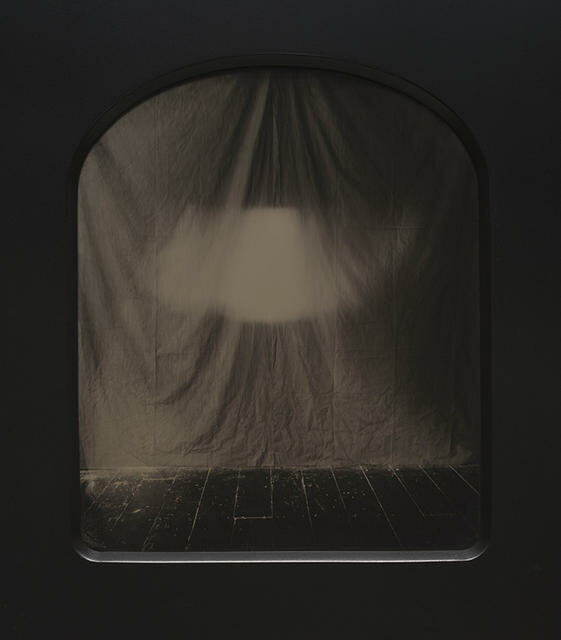Ben Cauchi
Aotearoa New Zealand, b.1974
Hovering Object
- 2005
- Ambrotype
- Purchased, 2005
- 250 x 200mm
- 2005/062
Tags: arches, draperies (curtains), interior, monochrome, psychic photography
The first photographs must have seemed like miracles or magic tricks. While early cameras became a valuable scientific tool, they were also associated with Victorian trick photographers, who faked ghostly apparitions and other spiritual phenomena. Ben Cauchi’s contemporary images play on this murky history. He makes ambrotypes, a process invented in the 1850s in which a glass negative is made to appear as a positive by placing it over a black background. Here, a strange shape or light emerges from behind the cloth backdrop of a photographer’s studio, creating a scene that vibrates with an unsettling tension. Like a cartoonist leaving one frame bare, Cauchi holds us in suspense, wondering what might come next.
(Absence, May 2023)
Exhibition History
As Time Unfolds, 5 December 2020 – 7 March 2021
By skilful sleight of hand, Ben Cauchi has singlehandedly given recognition to the previously little-known ambrotype, or wet-plate collodion positive process, within the sphere of local contemporary art. Now based in Berlin, the artist began exploring painstaking mid-19th-century processes during his photographic studies at Massey University in Wellington, just as digital photography was beginning to take off. Together with his affinity for historical technique, Cauchi reveals a partiality for the visual timbre of the Victorian photographer’s studio: here, the dark-stained floor and hanging cloth backdrop recall the makeshift collodion portrait parlours of gold rush days. The impression is disrupted, however, by the presence of a mysterious glowing, out-of-focus, hovering object.
Ben Cauchi is a contemporary artist who uses the techniques of nineteenth-century photography to make works that resist being placed in time. There’s a feeling of magic in all photography – the capturing of a moment, the way an analogue print develops in the darkroom through exposure to light – but Cauchi is particularly interested in the trickeries of Victorian photographers, who faked apparitions for a gullible audience. Here a blurry object appears to be levitating in front of a sheet. The one-off photograph is an ambrotype, a “mucky and noxious” process invented in the 1850s, where a negative image on glass is made to appear as a positive by placing it against a black background. “It’s the detachment of the image from the present that I enjoy about these processes,” says Cauchi. “The ability to give the work its own point in time so it’s not instantly recognisable as being from the now.”
(Now, Then, Next: Time and the Contemporary, 15 June 2019 – 8 March 2020)
Ben Cauchi plays on the mystique that surrounded early photographic techniques, in particular using camera ‘trickery’ to blur the boundary between truth and illusion. This ambrotype (positive on glass) shows an indistinct hovering object in front of a sheet. The stage-like effect recalls a 19th century conjurer’s trick or fake Victorian séance photograph. During the early years of photography many people believed the camera could capture apparitions of the spirit world invisible to the naked eye, and a variety of hoax photographs were produced that enthralled and terrified a gullible public. Clever and elegant, Hovering Object may no longer deceive a contemporary audience, but, as Cauchi is well aware, we are entranced nonetheless.
Cauchi received an advanced diploma in photography from Massey University, Wellington, in 2000, where he worked as part-time lecturer in photography the following year. Since 2004 he has been a full-time artist based in the Wairarapa.




